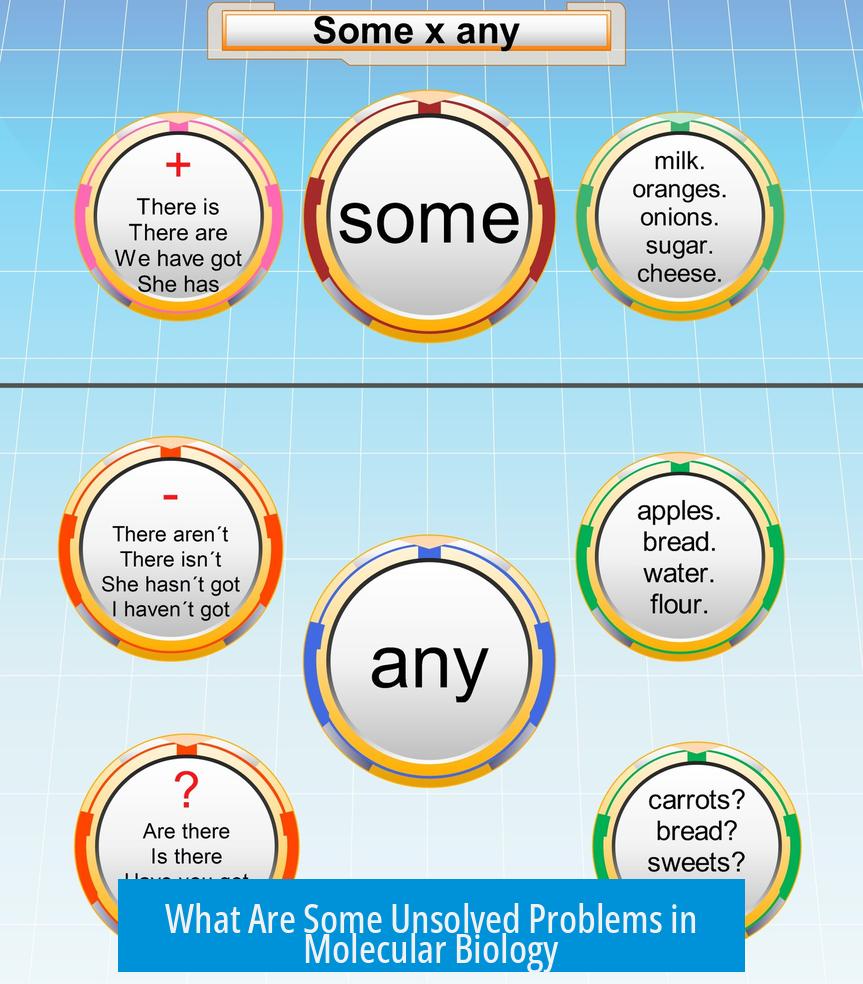What Are Some Unsolved Problems in Molecular Biology?

Molecular biology faces several unsolved problems, spanning from fundamental cellular processes to the origins of life. These challenges hinder a full understanding of biological systems and their evolution. The problems include questions about cell size, DNA repair, phase separation, and the role of non-coding DNA. Others target the evolutionary origins of life and viruses.
Cellular and Molecular Processes
- Liquid-Liquid Phase Separation: The mechanism behind how biomolecules separate into distinct liquid phases inside cells remains unclear. This process is vital for forming membraneless organelles.
- Cell Size Determination: Why cells maintain specific sizes within and between species lacks a definitive answer. Cell size impacts metabolism, division, and function.
- DNA Repair Mechanisms: Although known pathways exist, the full range of molecular details in DNA repair is not understood. Such mechanisms ensure genome integrity but vary widely among organisms.
- Functional Significance of “Junk” DNA: Whether non-coding DNA is truly non-functional or plays subtle regulatory or structural roles remains debated.
- Reproducibility in Molecular Biology Research: Confirming published experimental results is critical but sometimes challenging, raising concerns about data reliability.
- Role of Natural Deep Eutectic Solvents and Membraneless Organelles: Their precise function in cellular biochemistry and phase behavior calls for further research.
Neurodegenerative Diseases

The biochemical basis and molecular triggers of diseases like Alzheimer’s are still elusive. Understanding these pathways can guide therapy development.
Evolution and Origins of Life
- Metabolic Pathways of Earliest Life Forms: Identifying primordial metabolic routes would clarify life’s beginnings.
- Origins of Viruses: The exact timeline and mechanisms of viral evolution remain open questions.
- Extraterrestrial Life: The possibility of intelligent life beyond Earth and its molecular biology is speculative but debated.
- Molecular Mechanism for Amino Acid Codon Association: How amino acids became linked to specific triplet codons is not fully explained.
- Biochemical Paths to Functional Polymers: The transition from simple molecules to complex biopolymers like proteins and DNA lacks complete mechanistic detail.
- Origin of Sexual Reproduction: Why sexual reproduction arose and its evolutionary advantages remain partly understood.
Summary of Key Unsolved Problems

- Mechanisms of liquid-liquid phase separation in cells.
- Determinants of cell size and scaling.
- Details of DNA repair pathways and genome maintenance.
- Functional role of non-coding or “junk” DNA.
- Ensuring reproducibility of molecular biology studies.
- Impact of natural deep eutectic solvents in cellular function.
- Molecular origins and evolution of viruses and life.
- Biochemical origins of polymers and genetic coding.
- Processes leading to sexual reproduction’s evolution.
What Are Some Unsolved Problems in Molecular Biology?
If you’re diving into molecular biology, you’re stepping into a sea of mysteries. Scientists have cracked many codes, yet several problems remain puzzling. These enigmas range from how cells decide their size to the nature of ancient life. Let’s uncover some of these fascinating unsolved questions. Brace yourself for a molecular roller coaster!
Ever wondered why cells aren’t giant like elephants or minuscule like bacteria? Cell size determination is a conundrum that has bamboozled researchers. Why exactly are cells the size they are? The simple answer: we don’t know. Cells balance complex biochemical processes and physical constraints to keep their size manageable. But what precise mechanisms dictate this balance? There’s no definitive answer yet.
Treading deeper into the nucleus, DNA repair mechanisms present another puzzle. DNA, the blueprint of life, constantly faces damage from UV rays, toxins, and replication errors. Cells possess repair tools to fix these damages, but scientists are still decoding the full toolkit and its intricacies. Understanding these mechanisms can illuminate diseases like cancer and aging-related disorders.
Speaking of diseases, Alzheimer’s disease remains a biological riddle. What exactly drives the molecular degradation leading to this neurodegenerative condition? While amyloid plaques and tau tangles steal the spotlight, the complete molecular pathway isn’t fully mapped. This uncertainty stalls development of effective treatments. The quest to understand Alzheimer’s at the molecular level is urgent and ongoing.
Now, let’s talk about the infamous ‘junk’ DNA. For decades, many thought vast stretches of DNA were just evolutionary leftovers—useless sequences cluttering the genome. However, the debate rages: Does ‘junk’ DNA really exist, or does all DNA have some functional role? Evidence suggests regions once dismissed might have regulatory or structural roles. The definitive functions of many non-coding regions remain a hot topic.
Then, there’s an undercurrent issue troubling all molecular biology research: reproducibility. Science thrives on validation, yet many published findings stumble when repeated by others. Reproducibility in molecular biology research calls for stricter protocols and greater transparency. Trustworthy results accelerate discovery; unreliable ones breed confusion.
Diving into cell biochemistry, the role of natural deep eutectic solvents and membraneless organelles fascinates researchers. Membraneless organelles aren’t bounded by membranes but still compartmentalize cellular components. Their form and function involve phase separation—a process where liquids separate much like oil and water inside cells. This gives rise to liquid-liquid phase separation, a phenomenon whose implications on cellular regulation and disease are still unfolding.
Backtrack 4 billion years to life’s dawn, and the metabolic pathways of the earliest life forms remain obscure. What biochemical routes allowed primitive organisms to harness energy and grow? Scientists hypothesize pathways, but the actual metabolic blueprints of primal cells are lost in the abyss of deep time, a mystery yet to be cracked.
Curiously tied to life’s origins is the origin of viruses. Viruses blur distinctions between living and non-living entities. Exactly how and when different groups of viruses emerged is unknown. Their evolutionary trajectories could reshape our understanding of genetics and disease.
And while we’re contemplating origins, consider this: Could extraterrestrial life exist? Might molecular biology’s principles extend beyond Earth? The possibility that intelligent life might thrive somewhere else provokes exciting questions. If alien life exists, will it use DNA, or some molecular equivalent? This cosmic question remains open to speculation and wonder.
On the molecular code front, the association between amino acids and their triplet codons—the very basis of genetic translation—poses a challenge. What molecular mechanism originally linked those 20 amino acids to specific three-letter codons on RNA? Understanding this mechanism could shed light on how life’s language evolved.
Closely related is the pathway by which simple molecules evolved into functional polymers like proteins and DNA. How did individual bio-building blocks such as amino acids or nucleotides come together to form complex, functional chains? The biochemical routes for this transformation remain partly speculative.
Lastly, the origin of sexual reproduction puzzles biologists. Why did life evolve to mix genetic material rather than reproduce asexually? Sexual reproduction’s selective advantages probably lie in promoting genetic diversity and adaptability, but the exact evolutionary steps and molecular triggers are elusive.
So what’s the takeaway? Molecular biology is bursting with unanswered questions. These mysteries are not just academic curiosities—they affect health, technology, and our understanding of life itself.
Every unsolved problem invites research, debate, and discovery. From the nanoscale dance of phase-separated liquids in cells to the cosmic question of alien biochemistry, the frontier of molecular biology is vast and thrilling.
If you’re a curious mind, consider this: Which of these puzzles fascinates you most? Are you drawn to the molecular mechanics inside cells, the origin of life’s genetic code, or the mystery of brain diseases? Each unresolved problem is a chance to push science forward.
In closing, remember: science isn’t about having all the answers. It’s about asking the right questions—and molecular biology is full of great ones. Whether you’re a researcher, student, or enthusiast, following these mysteries might just inspire the next big breakthrough.
What is liquid-liquid phase separation and why is it important?
Liquid-liquid phase separation refers to the process where molecules separate into distinct liquid phases inside cells. Understanding it could explain how cells organize components without membranes.
Why do cells have a specific size?
Cell size determination remains unclear. Knowing why cells have particular sizes can reveal how cells optimize functions and manage resources.
How do cells repair damaged DNA, and what questions remain?
Cells use complex mechanisms to fix DNA damage. Yet, the full range and regulation of these repair systems are not completely understood.
What is the role of ‘junk’ DNA in the genome?
Not all DNA codes for proteins, but whether this ‘junk’ DNA has functions is debated. Research seeks to find if all DNA segments have a purpose.
Why is reproducibility a problem in molecular biology research?
Some studies fail to be reproduced by other scientists. This raises concerns about reliability and accuracy in molecular biology findings.
How did the earliest life forms metabolize energy?
The metabolic pathways of the first life forms are unknown. Uncovering these could explain how life began and evolved biologically.





Leave a Comment